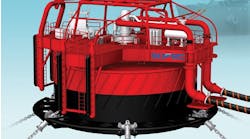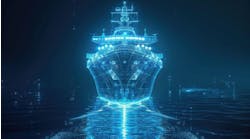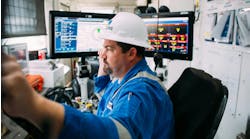Dealing with complexity, risk in deepwater projects
Neil Mackintosh
Mentor Subsea
Integration testing of subsea components lowers risk.
- Cost breakdown sebsea systems [17,148 bytes]
- Risk assessment - deepwater sebsea systems [16,494 bytes]
- Table 1[13,408 bytes]
While demand for deepwater products and services is very high, the supply side has yet to fully react. Hence, there are significant bottle necks in the provision of equipment, vessels, drilling rigs and particularly, trained and experienced personnel. Given this environment, what are the optimum methods for executing deepwater subsea projects?
In order to determine the optimum contracting strategy, we should review the breakdown of cost and risk for a deepwater project and implement a method that will mitigate risk while giving the operator greatest cost control.
The risk element associated with deepwater flowlines and pipelines is much higher than in shallow water due to the additional insulation/flow assurance requirements, the need to connect the pipelines using diverless techniques and the use of steel catenary risers.
If drilling costs are excluded from the equation (since they are normally contracted under a separate mechanism), the pipelines/flowlines are the largest portion of the cost and a large portion of the risk. Therefore, it is essential that any contracting strategy include early involvement of the construction company. This allows the construction company to Obuy inO to the overall concept, to influence the total project cost, and to provide early risk mitigation strategies.
Engineering is obviously an important element of the cost/risk control mechanism. A small amount of money spent on up front engineering can produce huge savings during the construction phase, when the large sums of money are spent and the risks are the highest. Therefore, the ideal contracting partner should provide a combination of subsea engineering and subsea/ pipeline construction expertise.
What key features are required from a subsea construction company so that it can add the most value to a deepwater subsea project?
Solution engineering
The construction company has to have a thorough understanding of subsea systems and be able to provide key engineering services including: subsea system design; flow assurance; riser design; installation design; subsea system installation engineering; pipeline design; and solution engineering. It is the combination of these skills which provide the best solution for a field development.The optimum solution for a field can take into account everything from technical feasibility and reliability through to CAPEX and OPEX calculations for life of field economic modeling. For a deepwater field, flow assurance issues will drive the system design and cost. However, early input by the contractor will determine the most cost effective solution for pipeline insulation/chemical injection and wax mitigation. Offshore equipment needs must be assessed from day one since the insulation requirements cannot be handled separately from the practicalities of installation/manufacturing.
A similar parallel can be drawn when looking at steel catenary riser design. At some stage the fatigue analysis has to be converted into a weld procedure, acceptable defect criteria, inspection method and an installation procedure. The sooner the contractor can have input into the design, the more effective this effort will be.
The contractor must have the ability to manage all subsea activities. This could include everything from steel catenary riser installation (J-lay), diverless connection system make up and the hook up and commissioning of subsea hardware. Therefore, a contractor has to have key equipment to perform some, but not necessarily all, of the installation activities. He must also manage other construction activities to provide a fully integrated subsea system.
The contractor should work closely with the engineers to ensure that systems can be easily installed and handled offshore. Recent projects have shown substantial cost savings through this integrated involvement in the up front design process. Many oil companies have yet to recognize the benefit of these savings.
Project execution
Contractors have to have management systems and procedures to effectively control the project. This includes all engineering, procurement and construction activities. This function is not normally implemented effectively by engineering companies, who understand little about offshore construction issues.Typical deepwater subsea developments have some or all of the following characteristics at project kick-off:
- Fast track requirements
- Incomplete data
- Parallel engineering and reservoir appraisal
- Fixed first oil date
- Uncertain drilling schedule.
Furthermore, the realities of today's market are:
- Long lad times for key subsea components
- Unreliable delivery schedules for subsea components
- Lack of experienced engineers
- Lack of qualified offshore personnel
- Use of new/unproven offshore systems and procedures
- Limited deepwater construction vessels.
- Vendor management: It is very important that there is close cooperation between vendors and contractors. Standardized components should be used wherever possible avoiding the need for expensive redesigns. Early buy-in by the vendors is important so there is a complete understanding of the total project schedule requirements. By adopting strategic alliances with vendors and service companies, contractors are able to negotiate long term pricing agreements. Cycle times are reduced due to the elimination of the bidding process and standardized components helping the vendor use stocking programs to reduce lead times.
- Integration testing: The management of all onshore integration testing activities is critical to the success of the offshore operations. This has to be managed effectively by the contractor and include all parties involved in the offshore operations, such as drilling, construction, ROV and hardware personnel. In deepwater, where error rectification will have a substantial cost impact, money spent up front in testing will more than pay for itself offshore.
- Rental tooling: Project economics are always improved through the use of rental tooling packages. Rental tools provide the added benefit of familiarity, which is particularly important for offshore installation. Tooling rental should include: diverless connection systems; workover control system; ROV tooling package; tubing hanger/ tree running tool.
- Diverless connection tooling: The lack of definition, the uncertain nature of the contracting mechanism and the need to allow for late changes in the delivery of system components, means that schedule flexibility is critical. Every effort should be made in the design to allow components to be installed at different times and in different sequences. In an environment when tasks in all offshore industries are being performed by personnel with little experience, systems should be made as simple as possible. Complex systems will be less reliable.
Offshore installation
Subsea construction activities will be shared between the drilling rig and the construction vessel(s). It is often the case that limited resources entail that vessels are selected for their availability rather than for their ability to perform the work.This is particularly true of drilling rigs, which have been modified/upgraded for deepwater drilling but not upgraded for deepwater subsea completions. Handling subsea equipment offshore is difficult and cumbersome, which often involves keel hauling of equipment and managing limited deck space.
The best solution for subsea construction may involve the use of more than one vessel. Therefore, it is important that there is a willingness and ability for construction companies not only to supply their own vessel(s), but also act as general contractor for other subsea construction activities.
Planning offshore activities will also demand a high degree of flexibility since it is not always possible for drilling/ completion work to be performed at the same time as construction work.
There are many opportunities for construction companies to take the leading role in deepwater pipeline and subsea projects. For the operator, there is a significant value added by taking this approach in terms of project flexibility, risk mitigation and cost reduction. In order to fulfill this role, contractors have to manage their business activities more as general contractors, rather than traditional pipeline installation companies.
Author
Neil Mackintoshis the Mentor Subsea Manager for Mentor Subsea, a J. Ray McDermott Company.Copyright 1998 Oil & Gas Journal. All Rights Reserved.


